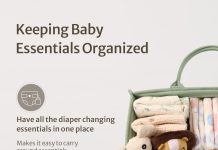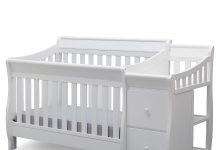It’s a girl! It’s a boy! It could be a boy or maybe both if you have twins. Your life will forever change after your newborn baby arrives.
You can expect that in the first month of your baby’s life.
The first few weeks of your baby’s life can be exciting and challenging.
You can learn how to feed, care for and comfort your baby so that you are not distracted by her needs.
Don’t be too worried if you are experiencing trouble today.
Review contents
A Guide for First-Time Parents
It might surprise you how certain different parts of your baby’s life can look from week to week at this stage.
Month 1: Your baby’s development
What’s the latest?
Let me help you relax: Your baby’s life is straightforward.
She only cares about eating every two hours, sleeping well, getting lots of love, and changing her diaper often.
That’s all.
For you, as a mother, it may seem more complicated. Focus on the essentials, your baby’s most basic needs. As you get more comfortable with the process, you’ll find plenty to keep your mind busy.
Do not do laundry or other chores during this time.
Ask for help from your friends and family. If you cannot cook, ask your family or friends for help. Do not bother checking your email.
If you have any questions about feeding, consult your doctor or a lactation consultant.
What does a baby look like?
Contrary to what you may think, newborns do not emerge from the womb looking perfect.
It can take a few weeks or even months for your baby’s appearance to change into the angelic-looking cherub you had hoped for.
Flattened noses can be easily manipulated through a birth canal to see if you get a cute button-shaped nose.
Your baby will soon change from a flattened nose to a conical head, especially if you push for an extended period. Ask your doctor about any concerns you might have.
Reflexes of newborn babies
Your baby’s reflexes are set up from the very first day. They protect your baby and make sure she gets the best care possible. Some of these early reflexes include,
• The rooting reflex (which helps her locate the breast or bottle for feeding),
• The sucking reflex (to help her eat),
• The Palmar reflex (this is the one that makes her grip your finger when you put it in her palm),
• The Moro reflex (the jumpy reaction she has when startled).
The senses of the newborn
From the moment your baby is born, her senses are activated.
• Vision. Your baby’s puffy eyes might be similar to yours. Your baby’s eyes may look identical to yours, but they are likely swollen after delivery. Although her vision is blurry, she can still see you. Antibiotic eye ointment administered right after birth.
• And other objects close up. You should ensure they are 8-12 inches from your eyes. That is her range of vision. You might also notice that sometimes she. That is because the muscles controlling eye movement aren’t fully developed yet. There’s nothing to be concerned about.
• Hearing. Your child’s hearing may not be perfect, but she is familiar with your voice and other sounds she heard in the womb.
• Taste. The baby has an excellent taste and can distinguish between bitter and sweet.
• Smell. Soon after it arrives, it will recognize your scent.
• Touch. Your baby’s sense of touch is the most important. This sense is most developed at birth. She learns that touching can make you feel soft and comfortable, that cuddling is good, and that her caregivers love her.
A curled body
Your baby will feel a bit scrunched after being sucked into your uterus. Her hands are small, and her legs are close to her body.
No worries. In the coming weeks, muscles will begin to relax.
Losing weight
Your baby may have weighed 7 pounds at birth, but don’t be surprised if her weight drops by 5-10 percent.
Average post-delivery fluid losses are the reason behind this decrease. At five days old, your newborn should see a steady decline in her weight.
She will regain or surpass her birth weight in 10-14 days, sometimes earlier.
Talk to your doctor if you are breastfeeding and cannot tell if your baby is receiving enough milk.
Newborn’s Sleep
just not all at one time. Your baby should rest for 14-17 hours per night, frequently waking to feed. Although it can reach 19 to 20, or less than 14, the National Sleep Foundation recommends that newborns sleep between 14 and 17 hours.
An average newborn sleeps for 16.5 hours each night between daytime and evening snoozing. However, there are many other options.
Breastfed babies need to eat every two hours.
Formula-fed babies (or babies who drink a combination of formula and breast milk) must eat every three to four hours.
You should feed your baby as often as possible and not by the hour. You may be able to spread your feedings out a bit more after a month.
It can be difficult for parents to adjust to this, especially when it’s time to feed their baby and put her to bed.
Continue to do this until the baby is well-fed. You can breastfeed if you wish.
If your partner is breastfeeding, pump some breastmilk so they or a friend can occasionally take a shift. You’ve probably heard it a million times: Sleep when your cat sleeps.
It will make a big difference even if it’s just a short nap.
Your baby will be in dreamland when she dreams.
You can rest in 100% safe conditions, reduce SIDS risk, and place her on her back on a firm, flat mattress.
How much milk does a baby need?
In the first few weeks, babies eat quite a bit — at most eight to twelve times per day (or more) for 24 hours.
It’s all due to her tiny stomach and the incredible growth she has undergone these first few weeks and months.
It can be hard to tell if your baby has had enough food because your breasts and baby do not have a built-in meter.
There are some clues. Suppose your baby is happy and her weight gains are appropriate for her age. She makes enough dirty diapers (8-12 on any day).
In that case, she’s likely getting enough.
That said, breastfeeding doesn’t always come naturally — and there are plenty of feeding tricks to master and issues to solve in these first few weeks, from the breastfeeding latch to mastitis and other common breastfeeding problems.
Do you need more information?
These breastfeeding 101s are available along with essential bottle-feeding tips.
Tracking dirty diapers
Speaking of dirty diapers, you can expect a lot from your newborn’s bowel movements in the first few weeks.
The first poops are often black and sticky. The meconium in your baby’s intestines during pregnancy makes them damp.
After a few days, the stool will turn greenish-yellow, and regular baby poops.
The average for the first month is prolific poop. Breastfed babies should have at least five diapers daily, and sometimes more.
Poop from your baby should be yellow, green, or brown. It will also appear pasty or seedy. Around week 6, your baby may stop poopy diapers completely.
Month 1: Your baby’s health
Crying
It’s not surprising that newborns cry. That is how they communicate. You’ll soon get used to the sounds and whimpers that baby makes, regardless of whether they are calm or fussy.
Sometimes crying is a sign that your baby is healthy.
Seek your doctor immediately if your child doesn’t often cry, especially if you suspect she might need something. What if she constantly seems to be crying? Some babies cry more than others. Research shows that between 80 and 90 percent of babies call daily for 15 to 30 minutes.
These crying episodes are hard to explain.
These sessions can sometimes be predictable, such as in the evening after a long day at work. Sometimes, they appear like an unexpected summer storm.
You should ensure that she isn’t hungry, hasn’t needed a diaper change, and hasn’t suffered from anything uncomfortable, such as a thread wrapped around her toes or a scratchy tag on her neck.
Once she is comfortable, rock her, take her for a walk, or sing to her.
Sometimes it may take several attempts to calm her down. If you lose patience or feel exhausted, it is okay to let her sleep in a safe place like her crib for a while. You might be surprised when she goes to sleep on her own.
Some parents wonder if their baby has colic.
Colicky babies will have more than just crying symptoms. They may also exhibit flailing limbs and gas. Doctors often diagnose colic using the “rule of threes,” three hours of calling per day for three days. This rule lasts at least three weeks.
One in five newborns experiences severe crying spells, which can be colic.
Though there are strategies for soothing babies’ cries, including those of colicky infants, sometimes nothing seems to work.
A few things the American Academy of Pediatrics suggests: swaddling baby, changing your diet if you’re nursing in case there’s a food sensitivity or gas, offering a pacifier, holding baby, running a fan or other white noise-maker that might remind her of sounds in the womb, etc.
To helps your baby with colic, it is essential to remain calm and share the attention with a caregiver or partner.
Colic typically begins around week 2 or 3 but usually peaks around week 6.
Your baby won’t likely be crying more by months 3-4. Remember, it’s a stage.
This month, more health 101s:
• Healing the Umbilical cord: No matter if your baby was born via C-section, vaginal birth, or speedy side-of-the-road delivery, newborns all have one thing in common: a stumpy and shriveled umbilical cord where the belly button should go.
Your baby’s umbilical cord should be gone entirely within the first few weeks. Until then, please keep it clean and dry.
Call your pediatrician if you have any concerns about foul-smelling discharge or if the area is still open and raw after the cord has fallen off.
• Umbilical Hernia: When your baby cries or moves in particular ways, you might Notice strange-looking bumps and bulges on her belly. You may be seeing an Umbilical hernia. That is not dangerous.
Your baby was receiving nutrients Via her umbilical cord back when she was still within you. A thick bundle of blood vessels entered her body through her middle — creating a small hole in her stomach muscles.
This gap can remain for a few months after your baby is born, which causes the intestines to bulge when your child strains. Most umbilical hernias are minor and resolve in a few months.
Larger ones can take a while. Most doctors will not recommend surgery to treat a hernia before age 6 or 7.
• Circumcision care: • You might be curious about what it takes to circumcise your baby boy. What is typical about his penis?
A newly circumcised penis must be kept clean and dry, just like the Healing umbilical cord. It’s normal for the body to experience some. It will take seven to ten days for your baby’s Circumcised penis to heal.
It is oozing or bleeding at the site of surgery.
Month 1: Parents
You are now a parent. You have made it through the many weeks of pregnancy, and now you have a bundle to show for it.
That could also mean that you might experience various postpartum symptoms, including hemorrhoids, vaginal soreness, incontinence (mainly if your perineal tear or episiotomy was used during delivery), constipation, backache, and sore nipples (especially breastfeeding).
Again, you will feel like an average person as your body heals and your baby settles into a routine.
Your postpartum body
Labor and delivery are so painful that six to eight weeks after the birth are considered “recovery periods.”
As your body heals and adjusts to the new life with the baby, you’ll need every support you can get. So, try to be a good mom by getting enough rest, eating right, and getting help from friends.
If you had a C-section, you’d also have surgery to recover from. Your incisions may feel tender and sore for up to six weeks after anesthesia or blood loss.
If the pain persists, cover it with a thin dressing and wear loose clothes.
You must reduce your activity to encourage healing and not strain the incision.
However, take a few short walks around your house to increase circulation and relieve any constipation or gas pains.
Read Next – Top-Rated Crib Mattress
What other changes can you expect in your body this month?
Breast engorgement usually occurs two to five days after delivery: That’s when your milk comes in, causing your breasts to become rock-hard and tender.
Prepare a warm washcloth for milk flow and a bra.
Cold packs or heating pads can be applied to your breasts to ease the discomfort and pain after breastfeeding.
Also, you will experience heavy bleeding, known as lochia.
You will need to use sanitary pads until the bleeding stops — typically after two to four weeks.
After childbirth, contractions known as after-pains help shrink the uterus to its standard size. It may take months to lose baby weight completely.
Many new moms also keep a few extra pounds after having a baby.
We are maintaining a healthy lifestyle.
Your focus should be on your baby’s health. However, it can become much more difficult if you aren’t healthy. Make your health a priority. You can get up early to sleep and nap whenever your baby needs it.
Even if you only have 15 minutes, you will feel surprisingly rejuvenated. It would be best if you always had a variety of nutrition-packed, easy-to-grab foods, such as cheese sticks, yogurt, cottage cheese, and fruit, on hand.
Breastfeeding mothers will need to ensure that they can graze often.
Finally, practice bottle- or breastfeeding positions to minimize back pain; you might even want to treat yourself to a massage from a partner if you have one or a professional.
Your emotions
This month will see fluctuating hormones, scant sleep, and a lot of emotional stress. You might feel overwhelmed, anxious, weeping, or irritable.
These feelings are normal and generally disappear within a few days after birth.
But sometimes, the feelings of depression linger and become more serious, which is why it’s essential to recognize the signs of postpartum depression (PPD).
Although the AAP recommends screening pediatricians for PPD every visit, many do not. Ask to be screened if yours does not, especially if you suspect you suffer from depression.
Depression is not something you should “suffer through,” and you certainly shouldn’t feel ashamed to seek the help you and your baby need.
Read Next – Smart Weigh Comfort Baby Scale with 3 Weighing Modes
Your relationships
Every couple feels like walking zombies during their first month at home with the baby. You are both going through an emotional time. Share as much of the experience as you can.
Even though sex is unlikely to be a part of this month’s plans, it will soon return to normal. Take a walk or give your partner a massage.
You can also go for a stroll together. Show your appreciation by cuddling, hugging, and kissing.
Read Next – Delta Children Changing Table and Storage
Things to do for your baby, who is one month old
Your tiny baby may seem incapable of doing the play, but you will be surprised.
Even the newest baby can form a bond with you, the most critical person in their lives.
You’ll be able to help her develop motor and cognitive skills while you enjoy this one-on-1 time.
The following activities target your baby’s blurry vision at one month (newborns can only see up to their arm’s length) and help her develop social, emotional, and emotional skills and listening skills.
Pick a time when your baby won’t be hungry, tired, or wearing a wet diaper. If she continues to turn her head away, it is a sign that she is becoming overstimulated.
• Don’t be silly. Infants are wired to be interested in human faces. That allows them to identify and bond with their caregivers quickly. The best part? She might even try to imitate you!
• Converse. Your baby should be held close to you to support her neck and head. Tell your baby a story, answer questions, or sing. Your gentle “conversation” with your baby is what builds trust. It shows that you are interested in her and can count on her to respond. Simplicity She loves to gurgle and coo as she hears the sounds.
• Play ball. That is the earliest version of “hide-and-seek,” and it strengthens your neck muscles. It’s also adorable! A bright-colored (not pastel, babies these young can see high-contrast colors better than pastel) ball or rattle near her will get her attention, and she’ll turn her back to search for it.
• Take a stroll. Take your baby with you, strap it into a stroller or carrier and go outside. You can describe the sights you see on your journey — cars, dogs, and horses. Both you and your partner will enjoy the fresh air and movement, as well as an increase in energy.
Read Next – Little Tikes Changing Table
Gerber Baby 8-Pack Short Sleeve Onesies Bodysuits, Solid White, Newborn
Spotted Play 2 Pack Sherpa Baby Swaddle Blanket - Ultra Soft Plush for Infants 0-6 Months | Receiving Swaddling Wrap - Ideal Newborn Registry and Toddler Boy Accessories | Nursery Blankets - White
$16.99 in stock
































